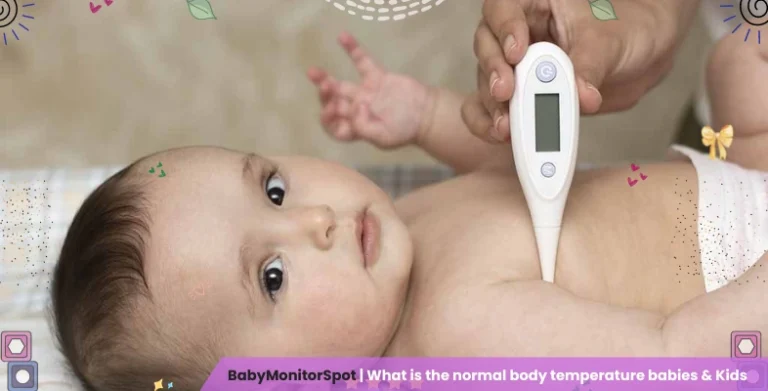What Is Normal Body Temperature for Babies, Kids, and Adults? Baby Guide 2023
-
Ejaz
- Published 2022-08-17
- Updated 2023-10-24

98.6 degrees Fahrenheit (37°C) is a normal body temperature in babies, kids, and adults. Body temperature depends upon factors like age, daily activity, weather, health condition, and the time of the day.
In this article, I will discuss normal body temperature for babies, kids, and adults, how you can determine if your child has a fever or not, and How they could be temperature affected. And at the end, I will discuss some essential FAQs.
How much is the normal body temperature?
The average body temperature is 98.6°F (37°C). But Although this is an average, your body temperature is probably slightly higher or lower.
By looking at their temperature, you can always tell if someone is sick. Several factors can influence your body temperature, including age, time of day, and activity level. In the age table below, you can learn about healthy body temperature ranges for babies, kids, adults, and older adults.
As you grow, your body becomes less able to regulate its internal temperature, so it tends to feel warmer. 65-year adults often find it harder to adjust to changes in temperature than younger people.
Here is the table about average body temperature for various age groups:
| Age | Oral | Rectal/Ear area | Armpit |
|---|---|---|---|
| 0–12 months | 36.7-37.3°C/95.8–99.3°F | 37–37.9°C/96.8–100.3°F | 36.4–37.3°C/94.8–98.3°F |
| Children | 36.4-37.4°C/97.6–99.3°F | 37–37.9°C/98.6–100.3°F | 35.9-36.83°C/96.6–98.3°F |
| Adults | 35.6-36.7°C/96–98°F | 36.1-37.2°C/97–99°F | 35–36.1°C/95–97°F |
| Adults over age 65 | 33.9–37°C/93–98.6°F | 34.4-37.6°C/94–99.6°F | 33.3–36.4°C/92–97.6°F |
It’s easier to know when you have a high temperature if you identify your normal range. This depends on your body temperature, which can change throughout the day. Your body temperature could be up to 1°F (0.6°C) higher or lower than the guidelines.
How can your body temperature be affected?
Body temperature is affected by many internal and external factors, such as food, activity, weather, and health conditions. A German doctor identified the average body temperature as 98.6F (37C) in the 19th century. There is a possibility that this is not the case. Many studies have concluded that that isn’t always the case.
Factors that affect body temperature are listed below.
- As we grow, our ability to regulate body temperature decreases, so older adults have lower body temperatures. Women and men have different body temperatures because of their body structure and hormones.
- Time of the day affects the body, and it’s called diurnal variation, which is connected to the level of metabolic activity. In the morning, it is low, and it increases gradually as the day passes. That’sThat’s why our body temperature is low in the morning.
- The body’s temperature can be affected by hormones, such as adrenaline and cortisol. Body temperature will increase when we respond to stressful activities like anger and fighting.
- Our daily activity also affects the body’s temperature. More exercise makes you feel warmer because your muscles are producing more heat.
- Weather is one of the main reasons for the change in our body temperature. That’sThat’s why our body temperature is high in summer compared to winter.
What is the temperature that is considered to be a fever?
A high than normal temperature reading is a sign of a disease. Generally, when your temperature is 2°F (1.1°C) higher than usual, It’s a sign of fever.
What are symptoms of a sick person?
Several signs and symptoms can be associated with the illness.
- Feeling sweating or feeling flushed
- A lack of appetite
- Feel weakness or lack of energy
- Pains and aches in your body
- Feel headache
- Feel coolness
- Dehydration of some sort
The hypothalamus has a built-in temperature control system in our brain. It controls our body’s temperature in response to illness and infection so that you can fight these infections on your own. It will take some time before your body temperature will return to normal without treatment.
What condition do I need to call my doctor?
Get medical advice if you have a fever or any of the following:
- There is confusion or sleepiness
- Being unwell
- There is a persistent cough
- There is unexplained bleeding or bruised body part
- Persistent diarrhea, vomiting, or both
- There is a throbbing head with a stiff neck
- If your fever hasn’t gone away after two days.
- Skin rash
- There is trouble with breathing
What are the fever conditions in children to call the doctor?
Knowing when to talk to a doctor with babies and younger children can be challenging. If your baby’s body temperature is 100.9°F/38.3°C or higher, you should call or visit your baby’s doctor.
You should also seek medical care for your baby or child if they have a high temperature and the following conditions:
- It appears to be very unwell
- Not easily to move an arm or leg
- There is pain with urination
- It’sIt’s cold and shivering for more than 30 minutes
- A temperature over 101°F
- When touched or moved, it’s inconsolable
- It appears dehydrated due to low urine amounts, dry mouth, and no crying
- Unable to drink liquids
- Has trouble breathing
What are the symptoms of Hypothermia?
Hypothermia is caused when you lose too much body heat. Hypothermia is when the body temperature drops below 95F. The average person thinks that Hypothermia occurs when it is cold outside, and they need to stay out for a long time. But Hypothermia can happen indoors too.
Older adults and babies are more susceptible. Hypothermia can be a concern in a poorly heated house in the winter and an air-conditioned room in the summer.
There are several signs and symptoms of Hypothermia:
- Shivering
- Shallow and slow breath
- Speech is slurred or mumbled
- Slow pulse rate
- Clumsiness or poor coordination is a problem
- It could be low energy or sleepiness
- A loss of memory or confusion
- The loss of consciousness
- There is bright red skin, and it gets cold to the touch
You should visit a doctor if your baby has a low body temperature and any of the symptoms above.
Is a temperature of 99 a sign of a fever?
99°F is a sign of a fever, And mainly it combines with other symptoms like shivering, breathing, and feeling low.
What is a high fever for a child?
100.4°F is the starting point for a fever. A temperature between 100.4°F to 1o2°F is a low fever and above 102°F is a high-grade fever.
What can I do to bring my baby's temperature down?
- It’s best to use acetaminophen
- You should dress baby in light clothes
- Make sure your baby is getting enough hydration
- Place a cold compress on it
- Provide your baby with a sponge bath
How long does fever last in kids?
A fever is typically short-lived and resolves over three to four days. However, it is not uncommon for a child with a fever to remain mildly febrile for up to three to four days.
Conclusion
It is standard for babies to have a body temperature of about 98.6 degrees. You want to see a doctor if your temperature exceeds 100.2 degrees Fahrenheit.
I hope you find this guide about normal body temperature very helpful. If you still have questions, you can ask in the comment below. I will answer in detail.
Keep visiting 🙂
Latest Posts







2 thoughts on “What Is Normal Body Temperature for Babies, Kids, and Adults? Baby Guide 2023”
Hi there, yup this article is actually good and I have learned lot of things from it
on the topic of blogging. thanks.
You are welcome.
Thanks for connecting.